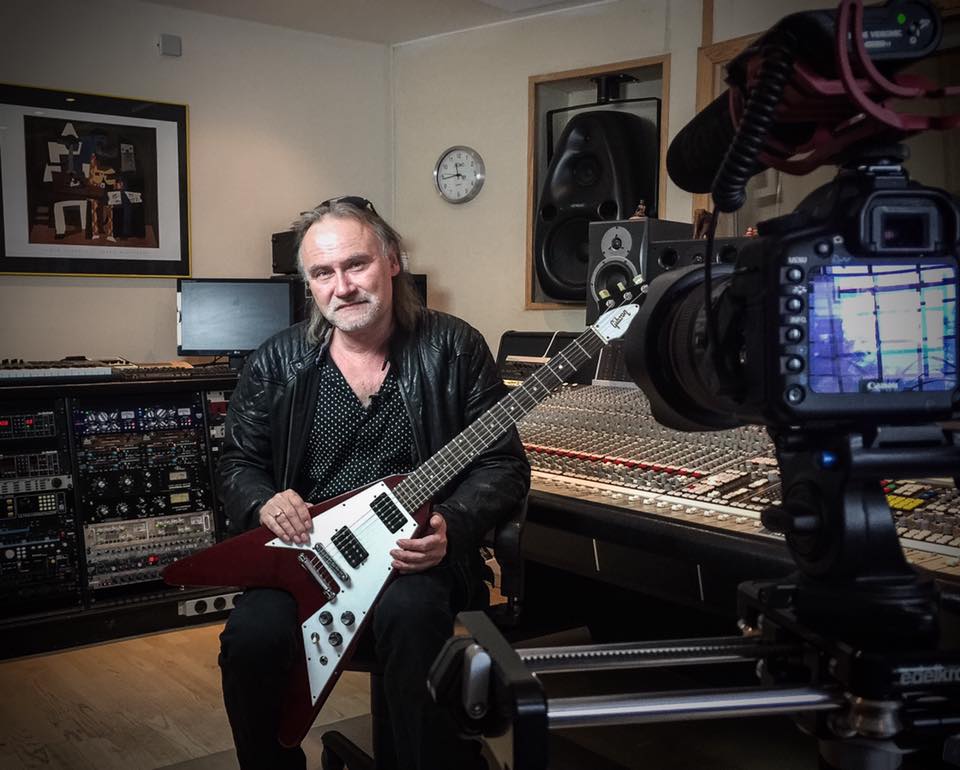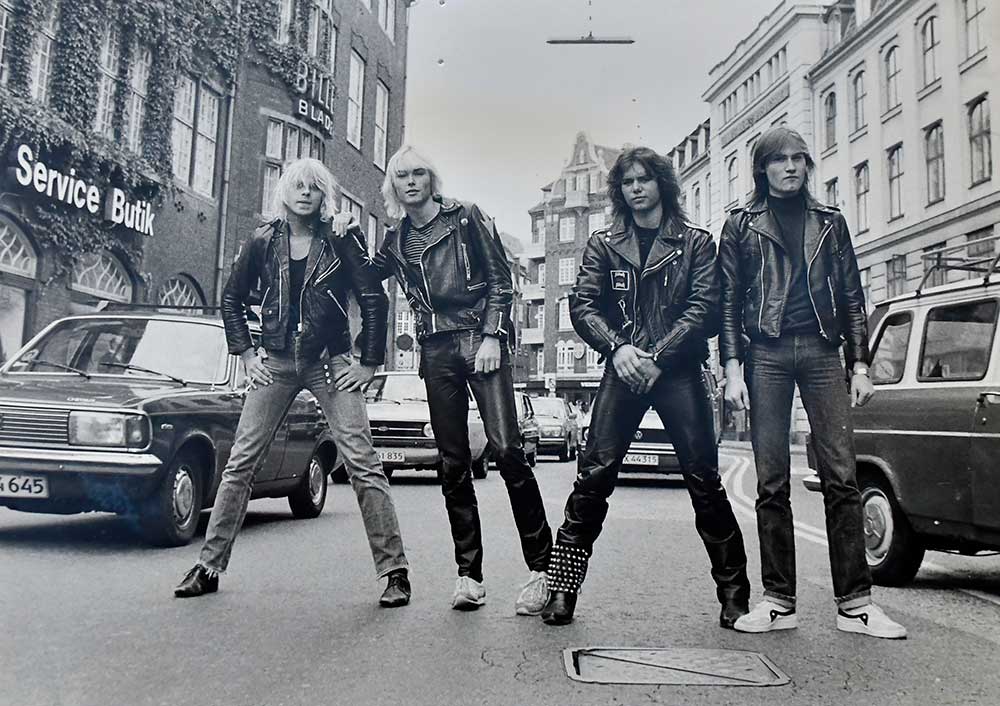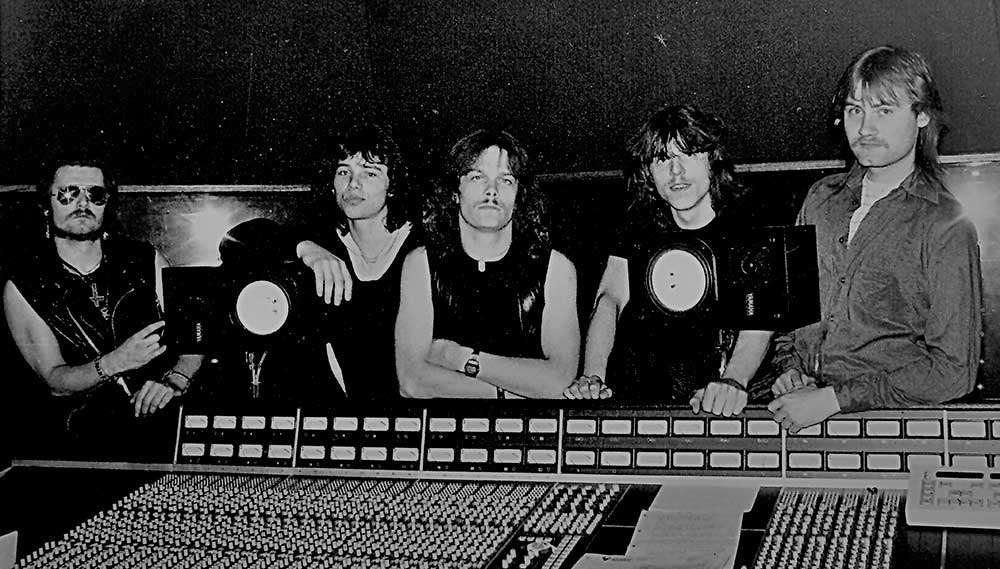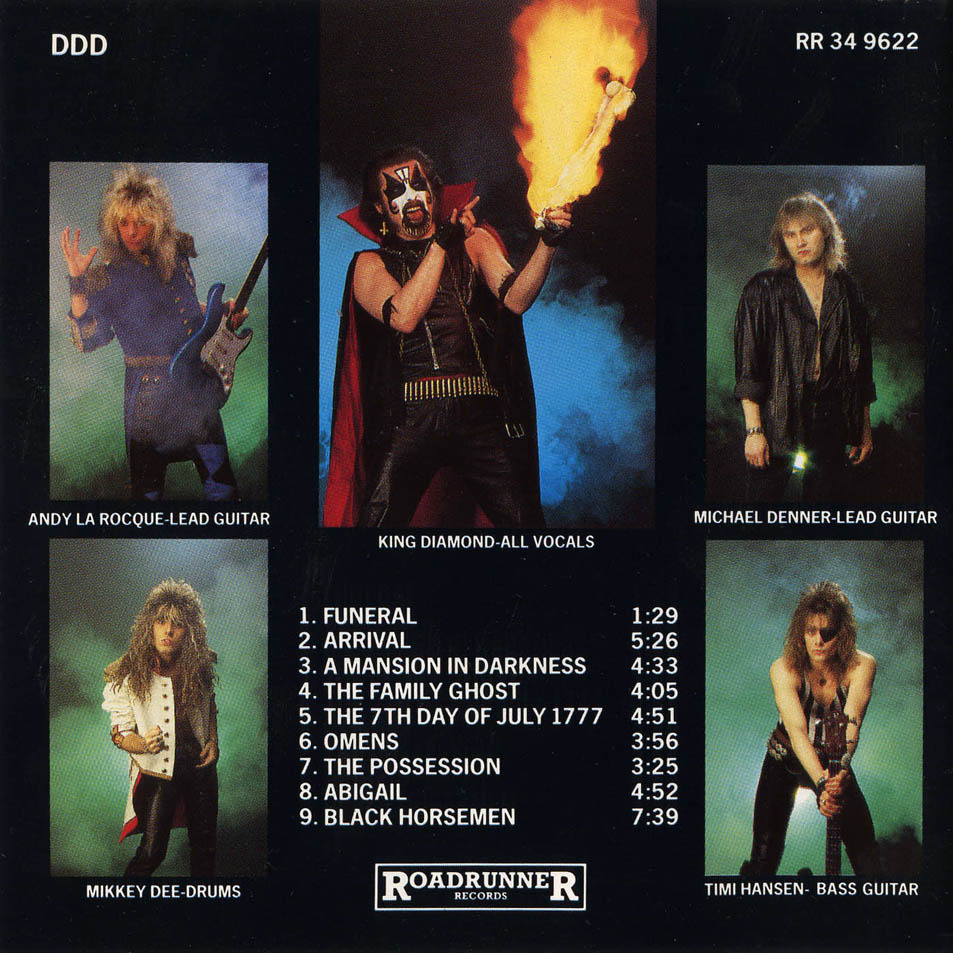Michael Denner (ex-King Diamond, Mercyful Fate)
2020-04-15
by Niklas Göransson
Legendary Danish guitarist Michael Denner gives a candid account of his long journey through heavy metal; from a childhood ravaged by witchcraft to the end of Mercyful Fate and conception of King Diamond.
Here follows the first part of this conversation, whereas the second – which is significantly longer and more in-depth – is published in Bardo Methodology #6. The same issue also includes features with FUNERAL MIST, DEAD CAN DANCE, DEATHSPELL OMEGA, SUNN O))), MYSTICUM, ADORIOR, Metalion, Dave Haley, OFDRYKKJA, NECROS CHRISTOS, TEITANBLOOD, and Wim Hof.
– I’m a huge record collector and have always been passionate about 70s heavy rock and the very early heavy metal. Long before death metal, black metal, thrash, and all that; I’m more into the doomier sides. I’ve wanted to do an album entirely in my own taste of music for years now but when there’s more than one composer taking decisions in a band, you’ll be forced to compromise. So, this time around, with my own band, I was able to do exactly that – which is why “In Amber” sounds the way it does.
“In Amber” is the November 2019 debut album of DENNER’S INFERNO, a new project courtesy of Michael Denner. One of my first observations was that the vocals differ significantly from his more falsetto-oriented work with DENNER / SHERMANN and FORCE OF EVIL.
– Many of the albums I made over the years was with vocalists who could pitch high. Look, I’m a huge fan of JUDAS PRIEST and Rob Halford but I wanted a different type of voice for this one. Something more in the vein of classic heavy rock, you know, like the DEEP PURPLE and URIAH HEEP singers. To give “In Amber” this 70s flair I was after, I needed a more bluesy regular-voiced vocalist. Actually, it was my record company, Mighty Music, who suggested Chandler Mogel – I looked him up on YouTube and immediately thought, ’Wow, this is exactly the type of singer I want.’ I got in touch and it turned out we share almost the exact same taste in music. He even sent me a photo of his record collection, which was quite similar to my own. Perhaps not when it comes to heavy metal, but he has a lot of 70s rock… all the PURLE albums, LED ZEPPELIN, BLACK SABBATH, all the music I appreciate. So, we clicked instantly.

You’ve mentioned having aimed for an ‘organic rock sound’ and so recorded the album in ‘the way it was done in the old days’ – is that to say you went analogue?
– We used analogue gear partly, but the main thing is that the rhythm sections were all recorded live – bass, drums, and guitars were played together in the studio. And these guys, Flemming Muus and Bjarne T. Holm – the bass player and drummer – they’re so skilled that I had no fear going in like this, I knew these guys would just nail it, you know, which is precisely what happened. I don’t think many bands record like this these days. It’s like going back to the good old days of MERCYFUL FATE; “Melissa”, for example, was played live in the studio.
In last week’s feature, Malte of NECROS CHRISTOS pointed out how high the level of metal musicianship was in the 80s – using precisely MERCYFUL FATE as an example. When recording on analogue tape, he explained, there’s no option of playing solos note by note or tracking the lead part a thousand times over, keeping the best seconds from each take and then puzzling them together.
– The studio we worked in at that point was hilariously expensive and our budget was very strict. So, we only had a few shots to place our guitar solos, and that’s what we did. I think being able to play like that gives the music an organic vibe. The thing is, when you do it like Malte described you can make exceptionally sharp solos but, then again, some of the charm and magic disappears because there are certain things you can only create in the heat of the moment; features you hadn’t even imagined could be done. Of course, there’s also a lot of mistakes but you can achieve absolute magic you never intended for in the first place. That’s what would often happen in the MERCYFUL FATE days – we entered our rehearsal room and magic happened. When I went in and played with these guys, you know, Kim Ruzz behind the drums. Timi ‘Grabber’, Hank Shermann, and King Diamond… I’d get goosebumps on a regular rehearsing day, because what we did was so awesome.
Taking a classic piece like “Gypsy”, for example, do you remember how it came together?
– It was actually King who found the basic riff and then we worked out the rest together, just him and I. The remaining song was built on that riff, I wrote the lead parts and all the stuff around it and then placed the solo for Hank. Mostly, we didn’t even have to say, ‘This is Hank‘s part, this is for Michael‘, because it became apparent as soon as we heard the riff. It was quite telepathic, and there was never any jealousy because we helped each other with the guitars, Hank and I.
One of the most celebrated aspects of MERCYFUL FATE is the guitar synergy between Michael Denner and Hank Shermann. The first time they played together was in 1980, whilst preparing to record an album with their hard rock band, BRATS.
– Back then, I believe Hank stole the show; I was the more technically skilled guitarist but he was such a powerhouse on stage. He was smokin’, could play fast and aggressive and had the looks and everything. So, I’d say I stood in his shadow during the early BRATS days. I was technically schooled and had much more experience as a guitarist and could play blues chops and all kinds of music. Hank took up guitar after hearing KISS – then he just started practicing, trying to play like Ace Frehley. That was in the late 70s, whereas I started much earlier. My father was a blues guitarist and I had a very different way of approaching guitar, compared to Hank. But he was aggressive and could play very fast leads, and that was important in those days when the fastest metal guitarists were also the best. Nowadays, everyone can play fast.

Hank and Michael played together until MERCYFUL FATE split up in 1985, only a year after “Don’t Break the Oath” and seemingly at the brink of commercial success. Hank Shermann formed an AOR band called FATE whereas King Diamond started his eponymous act.
– Both of them called me the next day, I had one in each phone saying, ‘Join my band, Michael.’ It was tough but only took me a split second to decide; I wanted to continue playing heavy metal. I really do love hard rock, you know, and melodic stuff – I have a lot of LPs like this in my collection – but for my career as a guitar player there was so much more room for me in KING DIAMOND. King promised me that we would write the songs together. ’You will be part of the production of the albums, and you could be my right-hand man on this’, so I said, ‘Okay, this is a good offer, I will join you, man. This is cool, we’ll just continue.’ And that’s precisely how we did it, and we had some good years after that.
Shortly after MERCYFUL FATE broke up, they received an unexpected promotional push from Tipper Gore and her Parent Music Resource Center – the American organisation that managed to get major labels to put these Parental Advisory stickers on records with mature content. The PMRC also issued The Filthy Fifteen, an index over morally corruptible songs parents should be on the lookout for. Among assorted works from the likes of Sheena Easton, AC/DC, VENOM, Cyndi Lauper, and MÖTLEY CRÜE, the list also included “Into the Coven” from “Melissa”.
– It was great – the best publicity we could’ve hoped for. Also, since these people were so silly and didn’t have much contact with reality at all, they were exposed later on. There was a congressional hearing with musicians like Dee Snider from TWISTED SISTER who just made them look like total fools. The rest of the artists on this list were superstars, you know. Suddenly, we were on a list with Madonna and Prince; these big, big, big names. All this had an enormous impact for us, it was beautiful. Honestly, you couldn’t even pay for such fine promotion, so that was super cool. A very good thing happened there.
Metal has always been associated with occultism and the darker aspects of the human psyche. I doubt many 80s bands with such lyrics had much first-hand experience though – Michael, however, had spiritism served in his mother’s milk.
– My parents were hippies and also experimented with various strange medicaments and similar shit, stuff that gave them visions. They started getting interested in the occult and so on, and even tried calling down spirits. When I was still a child, my parents gave me a pendulum – they would then place a photo of someone upside-down on the table, so I couldn’t see who it was. ‘Hang the pendulum over the photo. If it swings this way it’s a man, and the other way means woman.’ And every time they made me try, it swung in the right direction. There was clearly something from the outside coming in to take control of the pendulum, and it scared the shit out of me. We had a fireplace with this massive iron door; one evening during these sessions it just slammed shut, like, SHOOF! Also, my mother raised a ghost down by the lake nearby our house. I was scared shitless, the most frightened child in all of Copenhagen. My childhood was horrible, you know, really horrible.
Besides his parents, Michael also lived with two siblings – his brother and sister. The family of five shared a two-room apartment with no hot water in what he describes as a ‘very bad neighbourhood’.
– Big rats in the yard, cockroaches inside, and all that shit. And there was no bath; we had nothing. Then all the hippies came over and were just hanging around, smoking cannabis, acting like idiots, and falling asleep all over the floor. We had to go to school dirty and stinking of piss, so I got lots of beatings as a child. I was a very skinny, dirty little guy with long hair. Also, the school I went to for ten years was full of bullies and bad guys who’d been expelled from the other schools, So I had a very, very terrible childhood with very, very bad memories about spiritism. I was so scared. By the time I was about fifteen or sixteen years old, I’d started playing serious guitar and made some friends so I stayed away from home as much as I could. Then, the very day I turned eighteen, they threw me out. My parents asked me to leave, so there would be more room. I did, and then started building up my own life.
When Michael and King had just gotten to know each other, back in the very early days of MERCYFUL FATE, they would spend many nights listening to the first BLACK SABBATH record whilst discussing matters of magic and spirit.
– His interest in Satanism and ghosts and devils and ghouls and graveyards and shit got deeper and deeper while I was trying to avoid it – to get away from it, because I had such a terrible childhood with all these incidents. Of course, King was very interested in hearing about my experiences, so we spent countless nights sitting with a glass of beer and listening to doomy old-school heavy rock and discussing these things. That was one of the cornerstones of my friendship with King; he’s a deep thinker and talks a lot, just like me, so we had much in common back then. He also had a huge record collection and is an emotional guy who’s had a lot of difficult childhood experiences, so we connected really well. This might have been the deepest connection between the five members in MERCYFUL FATE, me and King. That’s why we became roommates on tour, because the rest said, ‘These two guys talk too much, let them live together!’ And sometimes when King got upset, I was the only one allowed in the room. If anybody else tried entering he’d throw a plant, a beer bottle, or something in their face, because he had this ferocious temper.

King Diamond has often spoken about his haunted apartment, did you ever witness any of this?
– No, never, but I certainly heard about it – Timi has told me and I’ve read what King says in interviews. But I never experienced anything in that apartment. I wish I did, because then I could add something to the conversation, you know? But, to be honest, I didn’t see anything like that there. Probably for the best though, since I was still terrified of darkness and ghosts and shit until I was around twenty-three years old. Once I came back home from the US tour with MOTÖRHEAD and EXCITER, I was a man and no longer scared of anything. Yeah, so that changed my life completely.
This December 1984 venture was the last classic-era MERCYFUL FATE tour and included everything from mafia loansharking to attempted armed robbery – all thoroughly discussed in the MERCYFUL FATE-oriented second part of this conversation, featured in Bardo Methodology #6. Returning to the timeline, I’m wondering what happened to the material Michael had written for the third album; if that’s what ended up in early KING DIAMOND?
– Yes, I did have quite a heavy song meant for the third MERCYFUL FATE, it turned into “No Presents for Christmas”. Well, except for the Christmas jingles, which were King’s. But the music side, all the heavy things you hear are mine. Also, “Charon” from “Fatal Portrait” was a song I originally wrote for that album.
Replacing Kim Ruzz on drums in the new project was a young Swedish musician called Mikkey Dee, he would later go on to become known as the MOTÖRHEAD drummer of twenty-three years. When recruited to KING DIAMOND he’d recently relocated to Copenhagen to play with GEISHA, a heavy metal band founded by former BRATS frontman Jens Arnsted.
– I remember the first time I met Mikkey; it was in my sister’s apartment on New Year’s Eve. Lars Ulrich from METALLICA was there with his cousin and we had a rock’n’roll party. Rumour had it that EUROPE were supposed to join but they never turned up. However, a lot of groupies and girls from the Copenhagen area heard about it, so all these chicks showed up, haha! The guys from GEISHA also came by, and all of them except Mikkey were shit-faced drunk. He was cool but the three other guys – Pete and Joel and Jens – acted as if they were MÖTLEY CRÜE, saying bad things and doing bad stuff, so we kicked them out. Mikkey and I went into the kitchen and started talking serious about music and career and so on. Him and I clicked immediately. I thought, ‘The rest are assholes, but I really, really like this guy.’ Afterwards, Pete and Joel apologised to me and we started hanging out. Some of them even lived in my flat at times. They were very, very poor at that point, GEISHA, all of them living in an apartment without electricity. I had a bit of money from my day-job so I sometimes brought them to my home, you know, invited them over for a hot meal, and we could sit and watch hockey on television together.
The original KING DIAMOND guitarist, Floyd Konstantin, was present in the studio for the recording of the debut album, “Fatal Portrait”. However, once his turn was up, it swiftly became clear that his lead work left some room for improvement.
– Suddenly we heard what we couldn’t hear in the rehearsal room. It was, like, ‘Wait, what’s happening here?’ King and I went to the studio’s kitchen area and I said, ‘This isn’t working out, we have to do something right now.’ So, we had no choice to but let him go. He was a cool guy though, I must say, and I later heard him play on some other album. He’s an okay guitarist, really, but at that point it didn’t work out. So, Mikkey said, ‘I know a guy in Gothenburg.’
This was Swedish guitarist Andy LaRocque, who still plays with KING DIAMOND to this day. Michael called him at 3:00am and he boarded a flight later the same morning.
– This quiet, soft-spoken guy turned up to the studio, he seemed like a cool and collected person. I said, ’Okay, I’ll let you listen to a song now – “Dressed in White”. Here is the solo part, start playing. Let’s see what you can do.’ Politely and quietly, he listened and then plugged in his guitar and started playing. I looked over at King, ‘Whoa, this guy can play!’ So, I said, ‘You’re hired, man.’ King let me make such decisions because this is who was supposed to play with me as second guitarist. Actually, we kept the solo he did for his audition, it’s what you can hear on the album. Then Andy and Mikkey moved into my apartment and we formed a great friendship. I honestly cannot say one bad thing about either of them. I think the only time we argued was when doing “Abigail”; the guys wanted to adopt more of an L.A. type of image, and I hated it.
“Abigail” was the 1987 follow-up to “Fatal Portrait” and remains the most successful KING DIAMOND album to date. Shortly following its release, Michael left the band.
– If you turn the LP around, you’ll see King Diamond with his makeup, three circus act artists, and this moody guy with a leather jacket sulking in the top corner, haha! We had a huge discussion in the rehearsal room and it ended with me slamming the door and saying, ‘I want no part of this! I don’t want to be a MÖTLEY CRÜE type of musician, I hate it. I want to look like BLACK SABBATH, man, not some clown from L.A.’ That pretty much sums up the story behind my departure. But that was back then. long time ago, now we laugh about this. Also, around the same time, I was supposed to marry my childhood sweetheart. The sad part about this is how right after I quit the band, she left me, haha! So, I ended up with nothing – story of my life. But, then again, this gave me the opportunity to open my first record shop, which was a cool thing. That was a compensation. But the discussion with the guys in the rehearsal room, that fired it up. It was the reason why I left KING DIAMOND in the first place.

You’ve reached the end of the first part of this conversation, the second – which is significantly longer and more in-depth – is published in Bardo Methodology #6. The same issue also includes features with FUNERAL MIST, DEAD CAN DANCE, DEATHSPELL OMEGA, SUNN O))), MYSTICUM, ADORIOR, Metalion, Dave Haley, OFDRYKKJA, NECROS CHRISTOS, TEITANBLOOD, and Wim Hof.



